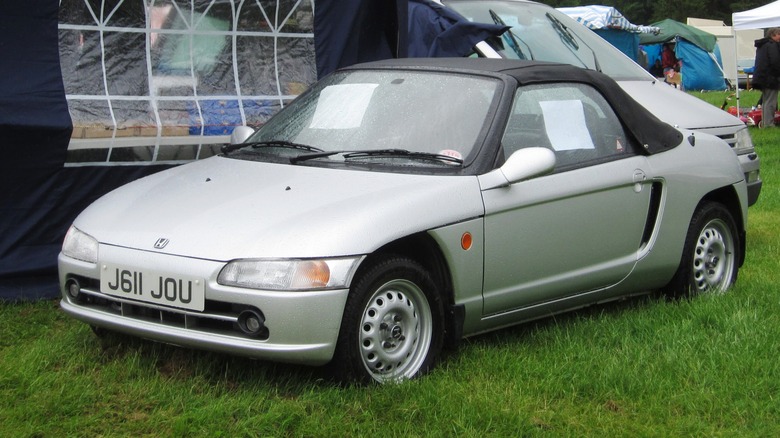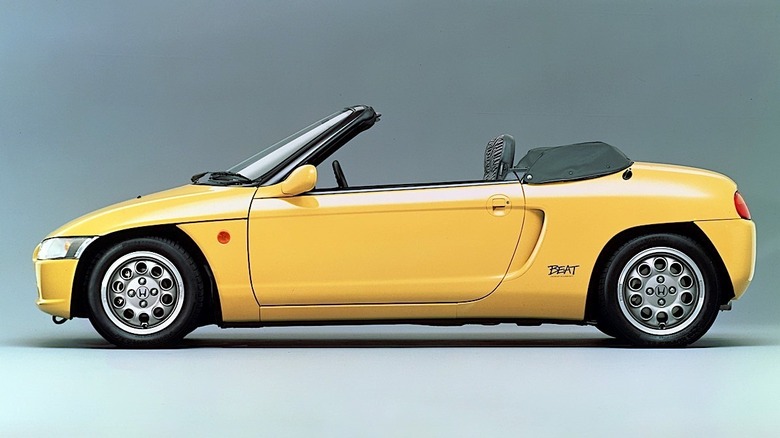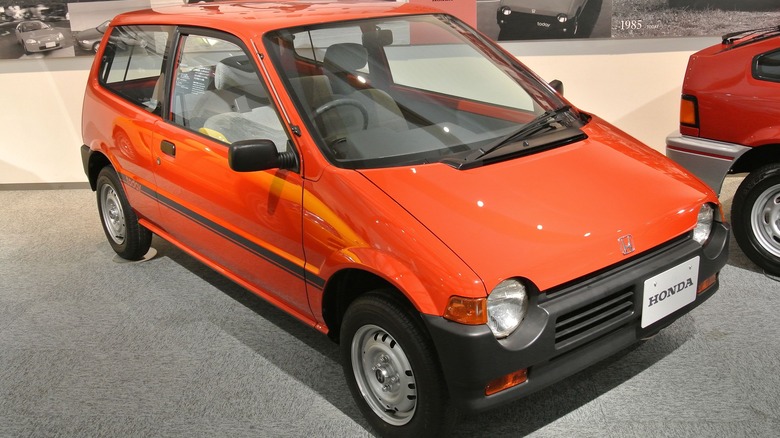Why The Honda Beat's Engine Is Considered Such An Oddball
The Beat is what resulted when Honda wanted to create a drop-top sports car within the confines of Japanese Kei car regulations. These rules say a vehicle needs to be of a certain size (tiny by American standards), and its engine can't exceed 660cc (so it's not going to be particularly quick).
It was made between 1991 and 1996, with just over 33,600 manufactured, and it's definitely among the awesome Hondas that never made it to the U.S. After it was taken out of production in February 1996, there was a 19-year hiatus before Honda introduced its successor, the S660.
The Beat's sporty Kei car rivals, like the Suzuki Cappucino or the Autozam AZ-1, also had to adhere to the cubic capacity cap, and their workaround to make more power out of their small three-cylinder engines was turbocharging. Honda chose a different solution (which we'll get to in a moment) for the Beat's engine, which had the added benefit of giving it a very high redline and a sound signature that could best be described as a mini-NSX.
Unlike the Beat's rev-happy three-pot, the engine in its successor, the N660, does feature a turbocharger. Even though it retained the midship location of the engine, it offered quite a different driving experience. There is nothing like going through the gears in a Beat, chasing the redline, feeling like you're going quite quickly, and then glancing down at the speedometer to see that you're only doing a little over 40 mph. It's all affordable Kei car fun.
[Featured image by Charles01 via Wikimedia Commons | Cropped and scaled | CC BY 3.0]
Individual Throttle Bodies
What Honda chose to do instead of turbocharging the Beat's engine was to give it individual throttle bodies for each of the cylinders. This was part of the MTREC (Multi Throttle Responsive Engine Control) system, which was basically bolted to the regular 660cc block that Honda used in its other Kei cars.
Individual throttle bodies are something you usually find on a high-end exotic supercar or a racing car, so the fact that Honda employed this solution for the Beat's engine makes this little unit quite remarkable. It didn't make any more power than its rivals back in the day, and it certainly made a lot less torque low down, but the fact that you had to rev it to 8,100 rpm to extract all of its 64 horsepower was a big part of its charm.
You could rev past the point where peak power is delivered, as the engine's redline was 9,000 rpm. Torque was not this engine's strong point, though, and to make matters worse, not only was there not much of it (just 44 lb-ft), but it was delivered at 7,000 rpm.
This means that just driving the Beat normally, it would not be uncommon to rev to 7,000 rpm while you're on your way to do some weekend shopping, and you're not even trying to drive quickly. And let's not forget all this is happening in a tiny open-top car with the engine buzzing away behind your ears — everything adds to the excitement.
The speed that the Beat can achieve isn't very exciting, though. The car is electronically limited to 84 mph and needs around 13 seconds to sprint to 60.
[Featured image by Andrew Bone via Wikimedia Commons | Cropped and scaled | CC BY 3.0]
The MTREC Engine Was Available In a Hatchback Too
Honda introduced the Today in 1993, a tiny hatchback, and it had a more powerful optional engine available, which it borrowed from the Beat. However, it was not used in the same state of tune, as it was remapped to deliver more low-end torque, which meant its outright oomph dropped slightly and peak power was delivered a bit higher, at 7,300 rpm.
In the Today, the engine made 57 horsepower and 44 pound-feet of torque, but this was delivered lower, at 6,300 rpm, and it made the vehicle feel a bit punchier lower down. Unlike the Beat, which was exclusively offered with a five-speed manual, the Today had an available three-speed automatic.
Opting for the automatic in a Today with MTREC made it easier to drive in town, but it wasn't much more relaxed, given that it still had to rev quite high before changing gear. This more powerful engine was dropped from the Today when Honda facelifted the model in 1996. This makes the MTREC-equipped models rare collectors' pieces that Japanese and overseas enthusiasts just can't seem to get enough of, and it's all thanks to the clever engine.
[Featured image by Rainmaker47 via Wikimedia Commons | Cropped and scaled | CC BY 3.0]


